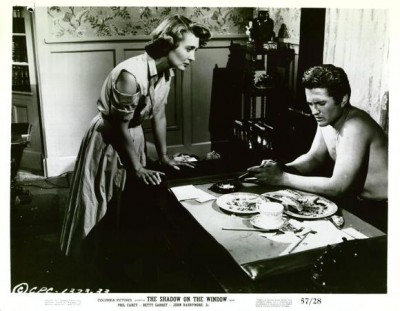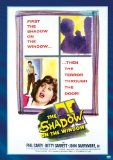| Reviews & Columns |
|
Reviews DVD TV on DVD Blu-ray 4K UHD International DVDs In Theaters Reviews by Studio Video Games Features Collector Series DVDs Easter Egg Database Interviews DVD Talk Radio Feature Articles Columns Anime Talk DVD Savant Horror DVDs The M.O.D. Squad Art House HD Talk Silent DVD
|
DVD Talk Forum |
|
|
| Resources |
|
DVD Price Search Customer Service #'s RCE Info Links |
|
Columns
|
|
|
Shadow on the Window, The
A "Sony Screen Classics by Request" title on DVD-R format, The Shadow on the Window is presented in 16:9 enhanced widescreen, approximating its original 1.85:1 theatrical version. The transfer is good and a trailer is tossed in as an extra feature.
Little Petey (Mathers) is playing outside when he hears his mother, Linda Atlas (Betty Garrett), scream and through a window he sees her brutally assaulted by three young thugs. Suffering from shock at the sight of this, Petey wanders out onto a nearby highway, where truckers find him in a state of catatonia. Petey eventually ends up at a police station and is later taken to the hospital.
Nobody knows who he is until an officer recognizes him as the son of Detective Sgt. Tony Atlas (Philip Carey), who has been separated from Linda for the past two months. Even after he's reunited with his father Petey remains totally unresponsive, and Tony is increasingly concerned about his estranged wife's safety and whereabouts. An investigation is set into motion.
Meanwhile Linda tries to escape, or at least talk her captors out of killing her. It turns out she's a freelance stenographer who had been doing some work for a wealthy old man when Jess Reber (Barrymore), Gil Ramsey (Corey Allen), and Joey Gomez (Gerald Sarracini) broke in and Joey killed the old man with his bare hands. Most of the film follows Tony's investigation trying to trace Petey's movements back to where his mother disappeared, and the various setbacks along the way. (One clue gets delayed because a key witness is cheating on his wife and doesn't want to be found.)
The Shadow on the Window is competent if derivative, though Mathers's incredible performance makes this essential viewing. He has, I think, one word of dialog in the entire movie, and spends almost the entire picture staring shock-still, yet what's behind those eyes is very realistic and deeply disturbing. His expression is almost boredom, but through it Mathers conveys a sense of having seen something so unspeakably horrible that it has frozen his face into a state of paralysis. And a performance it is: where Sandy Denscher's little girl in Them! (1954), also frightened into a state of glassy-eyed shock, basically just stares off into the distance, Mathers genuinely looks traumatized. It's even upsetting to look at him in that state. I wonder how he was directed, and where that look came from?
The rest of the film is generally good, though damaged slightly by some of the other performances and some wobbly writing. John Barrymore, Jr. is quite hammy and even unprofessional as Jess, the most sadistic of the trio. Gerald Sarracini is significantly better as Joey, the most violent yet also most sympathetic of the three, who argues against killing Linda, who in turn manipulates him, hoping he'll protect her.
Betty Garrett, fine in this, was then known primarily as a star of musical comedies. She made a strong impression in On the Town (1949) and My Sister Eileen (1955), but her winning personality was stifled by the Hollywood blacklist, with her husband, actor Larry Parks (The Jolson Story), being one of its most tragic victims. Garrett enjoyed a career resurgence in the 1970s on sitcoms like All in the Family and Laverne & Shirley, and she remained a much-loved and admired pillar of Hollywood's acting community until her death earlier this year at 91.
Ironically the three actors tormenting her in The Shadow on the Window weren't as lucky. Barrymore, the son of actor John and the father of actress Drew, was an abusive alcoholic and drug addict. ("I'm old enough to drink," Jess says, breaking into the liquor cabinet. "Wanna see my driver's license?") That and his tendency to walk off sets in the middle of production ruined his reputation and he spent his later years as a veritable derelict. (I recommend his IMDb bio page, which includes a gruesome account of Barrymore's literal if alleged grave robbing of his famous father's body.) Gerald Sarracini, very good as short-tempered Joey, was himself beaten to death while walking home following a performance of Romanoff and Juliet on Broadway. Corey Allen enjoyed a 20-year-long career as a television director after giving up acting around 1970, but in later years he suffered from debilitating Parkinson's Disease.
Philip Carey was a decent enough actor, though his performance and his character, as written, strain credibility. Instead of a growing sense of dread at his son's condition and the realization that his wife might just be dead, Tony barely reacts at all. He's too cool a cucumber to be believed, even if he is a cop. Though less acceptable today than it would have been in 1957, it's also hard to believe the police would in essence allow Tony to lead the dragnet in search of his missing wife. (Spoilers) The film becomes almost ludicrous at the end: when he and Linda are finally reunited, he rushes right past her, not stopping to see if she's even okay, in order to confront Jess in a manner that's neither satisfying nor believable.
Apropos of nothing, two little bits of trivia: Linda brings Petey along with her because after her stenography job she had planned on taking her boy to Disneyland. This may the first mention of the theme park in a feature film, and almost certainly one of the few in a non-Disney production, though Disneyland does become the target of invading Martian terrorists in another Columbia film, The Three Stooges in Orbit (1962). Something else that surprised me was that, near the end, Jess takes off his t-shirt and actor Barrymore is revealed to have a positively enormous scar running from the middle of his chest and across his left shoulder. I'm not sure what the significance of this is but I found this startling nonetheless.
Video & Audio
Filmed in black and white for 1.85:1 projection, The Shadow on the Wall looks very good generally, with a solid video transfer and decent mono audio (with no alternate language or subtitle options), though on my copy I noticed a few video minor imperfections that could be the authoring or maybe just my DVD-R. In any case they weren't too distracting on what was otherwise a nice presentation. There are the usual chapter stops every ten minutes.
Extra Features
The only supplement is an amusing trailer, promising a picture "so exciting it will take you an hour to calm down!" (pant-pant)
Parting Thoughts
For Jerry Mathers's performance alone The Shadow on the Wall is worth seeing, though the rest of the movie is pretty good, too, and overall heartily Recommended.
Stuart Galbraith IV's audio commentary for AnimEigo's Tora-san, a DVD boxed set, is on sale now.
|
| Popular Reviews |
| Sponsored Links |
|
|
| Sponsored Links |
|
|
| Release List | Reviews | Shop | Newsletter | Forum | DVD Giveaways | Blu-Ray | Advertise |
|
Copyright 2024 DVDTalk.com All Rights Reserved. Legal Info, Privacy Policy, Terms of Use,
Manage Preferences,
Your Privacy Choices | |||||||















